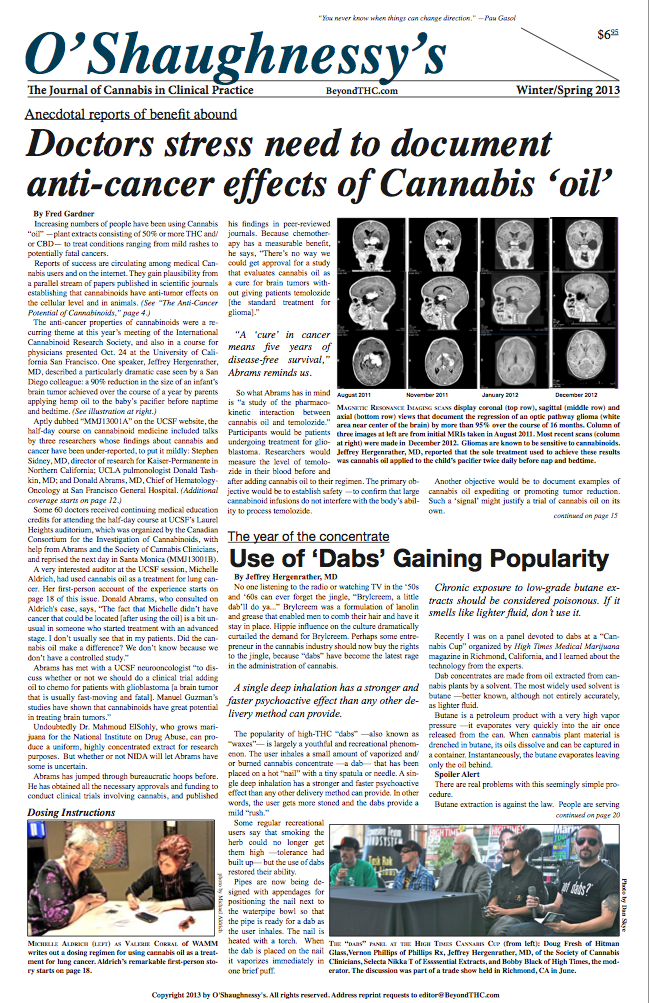By Fred Gardner March 20, 2013
The Winter/Spring 2013 issue of O’Shaughnessy’s came out February 14 with a page-one article by Jeffrey Hergenrather, MD, under the headline “Use of ‘Dabs’ Gaining Popularity.” It explained:
“The popularity of high-THC ‘dabs’ —also known as ‘waxes’— is largely a youthful and recreational phenomenon. The user inhales a small amount of vaporized and/or burned cannabis concentrate —a dab— that has been placed on a hot ‘nail’ with a tiny spatula or needle. A single deep inhalation has a stronger and faster psychoactive effect than any other delivery method can provide. In other words, the user gets more stoned and the dabs provide a mild ‘rush.'”
Hergenrather expressed concerns about the health impact of dabbing. Butane and other toxic solvents may leave residue on the concentrated cannabis oil inhaled by dabbers. Tiny, toxic particles can flake off from metals that seem inert. Moreover, Butane is illegal and dangerous to use as a solvent. “Butane is a fire and explosion risk because it is highly flammable,” Hergenrather wrote. “Many people have been severely injured using butane to make cannabis oil extracts.”
Hergenrather’s piece was accompanied by a memorable Dan Skye photo of the white-haired MD flanked by much younger dabbing-equipment manufacturers at a “Cannabis Cup” event held in Richmond, CA, in June 2012. (Some call the paraphernalia “oil rigs.”)
Dale Gieringer, the director of California NORML, emailed a note to our website, BeyondTHC.com, adding another concern: hypotension.
“We have recently begun to witness 911 crews called in to handle users who have passed out from dabbing and concentrate overdoses,” Gieringer reported. “This is something I never saw until dabs become popular. I’m aware of three such incidents at a recent gathering in LA and several more at a cannabis cup in SF. A lady my age [60ish] who has been smoking since the ’70s fell down and broke her front teeth after dabbing. Someone else passed out and nearly cracked his skull on the sidewalk. When 911 crews need to be called in, there arise serious questions about a drug’s safety. Cannabis advocates need to take the dangers of dabbing seriously.”
Immediately the activists’ chat rooms resounded with warnings over the p.r. implications of dabbing. The experts feared that discussing the potential dangers would damage the industry’s image. From far away Washington, D.C., the Marijuana Policy Project’s Communications Manager advised
“The growing popularity of dabs among younger recreational users is a media disaster waiting to happen and could easily lead to all sorts of overly strict regulations on concentrates in future legislation. Folks should be careful not to promote this in the press, and the makers of oil rigs and other associated concentrate paraphernalia should go to greater lengths to conceal the heating mechanism or otherwise make the devices look less intimidating to non-users.”
I emailed her that I didn’t appreciate the call for self-censorship. She replied:
“As far as I can tell, most people don’t know about dabs unless they are heavily involved in the marijuana industry or culture. I’d like to keep it that way until we pass a few more laws 🙂 Please keep this conversation off the record and off-list.”
It’s very unrealistic of the MPP Communications Manager to think the mainstream media is not going to pick up on the dangers of dabbing. It’s already happening —this morning in Petaluma a 15-year old burned his face and hands making hash oil with butane. (The labs now refer to the product category as “BHO,” butane hash oil). Also, it’s immoral to instruct someone to tell a lie of omission. And it’s arrogant to demand confidentiality from the editor of a publication whose story she’s trying to suppress. The pros Back East couldn’t spike the story in advance, and now that the rank-and-file are discussing it in the boondocks, they’re trying to shshsh us. The hell with that.
You don’t have to be a p.r. professional to see that dabbing blurs some distinctions between the mild herb and processed “hard drugs” that come on with a rush. The suggestion to hide the inner workings of the dabbing devices is revealing (and symbolic, like a French movie). From whom would the glowing mechanism actually be hidden? Ninety-nine times out of a hundred it will be the dabbers themselves seeing the heated spike, not some abstract opponents of drug policy reform. Hergenrather wrote, “Metals such as steel, stainless steel, or titanium might seem inert, but in fact they flake off a layer of metal with the dab.” Why hide from the users a reminder of possible harm? Why hide reality?
There’s no need to spin things when you have the truth on your side. Pot partisans should simply tell it like it is —about dabs and everything else. O’Shaughnessy’s proudly claims responsibility for publicizing Dr. Hergenrather’s concerns about dabbing; but max credit goes to David Bienenstock, the editor of High Times Medical Marijuana magazine, which sponsored the panel on dabbing at their June 2012 event and invited Dr. Hergenrather to be on it. This approach —our approach— is in sharp contrast to the way biomedical device makers introduce and promote their products in the corporate world. At their trade shows, on-the-take scientists extol the virtues and ignore the adverse side-effects. At the High Times Cannabis Cup, an honest clinician was invited to express his concerns.
Inevitably, Nora Volkow of NIDA or some official from the Drug Czar’s office will put out a warning about dabs, and spokespersons for the marijuana industry will dismiss that warning as baloney. It’s a shame that our government officials are biased, but a counter-bias will not help us evaluate the safety and efficacy of dabbing. As consumers and as parents, we want the straight facts. The Marijuana Policy Project ought to be publicizing the findings and observations of Hergenrather and his colleagues, not suppressing them. Then, when prohibitionists start spreading scare stories about dabbing, the Communications Manager can tell the world, “Our community is trying to nail that down (pun intended). Nobody has a greater stake in assessing the safety of dabs than cannabis consumers. Cannabis clinicians have been looking at which solvents, if any, are safe. The proper response to the dangers of dabbing is education, not punishment. It’s too bad the government doesn’t fund the relevant research. Etc. etc.”
PS to the MPP Communications Manager: You can act on the above suggestion immediately! Four cartons of O’Shaughnessy’s with “Use of ‘Dabs’ Gaining Popularity” on page 1 were sent to the Mayflower-Renaissance hotel for distribution by Dr. Hergenrather at the ASA conference. They did not arrive on time and are now sitting in the shipping department, a few blocks from your office. You are hereby invited to pick them up and distribute them to your media and political contacts.
If you act now, you can have this amazing journal —64 pages of content, no jive— for just the cost of shipping and handling. That’s right —they can be yours with no payment to the publisher for distribution to journalists, Congresspersons and their aides, and others in your influential entourage back there in D.C. But wait, there’s more! By distributing O’S, you will not only be pre-empting scare stories about the possible dangers of dabbing, you will be educating the people who most need educating re cannabinoid concentrates. Dr. Hergenrather’s piece is slugged “The Year of the Concentrate,” and the story above it on the front page reviews the mounting anecdotal evidence that cannabis ‘oil’ can have anti-cancer effects. Oncologist Donald Abrams, MD, explains what it will take for the federal government to sponsor a study of cannabis oil. Dr. John McPartland discusses “The Care and Feeding of the Endocannabinoid System.” Findings from the International Cannabinoid Research Society are reported. The significance of sequencing the genome of the cannabis plant is explained. Talks at a UCSF-accredited Continuing Medical Education course for doctors are summarized… And it’s yours to distribute, just for the cost of shipping and handling. Don’t be ashamed of the dangers-of-dabbing story —distribute it and take credit for it!
Our operators are standing by at editor@os-extra.cannabisclinicians.org.





